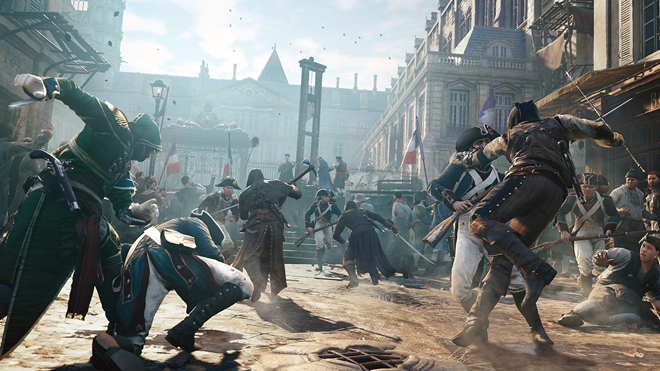Quarantine Control #11: The Apocalypse Odyssey Tales

Several cities, states, and countries around the world have been slowly reopening with the overall spread of the Coronavirus going down, and we’re very quickly seeing how big a mistake that was on some of their parts — especially in the United States. Several municipalities in the country have allowed too many people to go out too early, with the number of people testing positive for the disease reaching record highs in states like Texas and Florida. It’s utterly bonkers stuff, but their governors are doing nothing to protect people, and are actively sending them to their deaths.
Basically: You all need Quarantine Control now more than ever. Fortunately, some of us are here to share more about what we’ve been doing.
Geoffrey Barnes
Assassin’s Creed Odyssey (2018)
Source: PlayStation 4
It’s a video game

I’m taking a slightly different approach this week, out of necessity. I, uh, haven’t watched anything in the last week — though not because I was too distracted by the news this time, as easy as that can happen. Instead, I spent too much time playing Assassin’s Creed Odyssey, the most recent very long and very addictive entry in the series. It’s also the second entry in the series’ new The Witcher 3-inspired action RPG direction, following Assassin’s Creed Origins. I’m enjoying this title as much as that one, but I plan to review the game in a separate post. Here, I’m going to talk about how the word “formulaic” doesn’t always have to be used in a bad connotation.
Make no mistake: Odyssey is formulaic. Its feature set is largely identical to its predecessor’s outside the setting switch from Egypt to Greece, minor changes to the combat (blocking is replaced with parrying), an altered defensive equipment system, and the return of an emphasis on sailing and piracy like Assassin’s Creed IV: Black Flag. It’s very much a Ubisoft sequel, with a monotonous structure that represents the so-called Ubisoft Formula™. I’m around 46 hours into the game at this point, and I’m not going to lie here: I’m having a great time.
In fact, I’m surprised I’m enjoying it this much. The combat is barely different from the acceptable-enough battles from Origins, and many enemies populate similar-looking environments in camps (almost all of which have the same designs), forts, and expensive-looking places. It feels like the gameplay features aren’t diverse enough to support such a long game. I’m closing in on 50 hours, and guides suggest that I’m only around two-thirds of my way through the main story quests. This is a big, big game, easily longer than Origins.
That’s not including the side quests, which there are plenty of in varying quality. Side stories that appear in the form of question marks can actually be more rewarding than they let on initially; some even have resolutions to plot points introduced in the main story. Other side quests are more rudimentary for open world games, which involve delivering items to other characters or assassinating someone who wronged the quest giver. The point is, you won’t see anyone complaining about not having enough content here. The fear is actually that I’ll get burnt out and complain about having too much content by the end, but I hope that doesn’t happen.
It’s the sense of adventure and discovery that’s kept me going. Odyssey’s world of a somewhat-fantastical Ancient Greece is massive, full of historical locations and small islands that will take hours on end to discover. This could eventually suffer from the same fate as Origins, where a good chunk of the last series of locations consist of largely empty islands that nonetheless look beautiful, but even that could be rewarding if there’s good treasure to be found and plenty of environmental ambience. It’s also a real looker for an open world game, and here I’m still using a base PlayStation 4.
I can’t guarantee that Odyssey will keep my attention. As I mentioned above, the repetitive-though-fun Ubisoft Formula nature has me concerned that I’ll want to bounce off if I stop enjoying it. But the fact that it’s kept my attention for so long means the chance of that happening is low at the moment. You’ll see a review of it on this blog if I finish it, but if I do get tired of it, I’ll provide an update in this feature.
Angela Moseley
Recently, I’ve gotten into the bad habit of bouncing around in video games. I’m still slowly making my way through Final Fantasy VII Remake, Fire Emblem: Three Houses, Detroit: Become Human for livestream, and the occasional sessions of Monster Hunter World: Iceborne. I’ve picked up my 3DS again and instead of finishing Phoenix Wright: Ace Attorney – Spirit of Justice I’ve gotten myself into yet another JRPG.
Shin Megami Tensei IV: Apocalypse (2016)
Source: Nintendo 3DS
Episodes: 1 video game

At the end of April Nintendo revealed it would be shutting down the 3DS and Wii U eShop in more than 40 countries. North America wasn’t on the list, but it is only a matter of time before the plug is pulled. That got me to thinking I should buy the games I want on the 3DS sooner than later. Shin Megami Tensei IV: Apocalypse came to mind. To my shock the game had gone up in price and now cost over $80 when at one point it had been as low as $20 on Amazon. I checked other online outlets, but the game was either unavailable or really expensive. I ultimately purchased a copy on the eShop for $30. When I bought the game I intended it to go into my backlog, but temptation called and I answered.
Shin Megami Tensei IV: Apocalypse is a side story instead of being a full sequel. It takes place near the end of SMTIV after Flynn (the protagonist) is locked into the neutral route. His former companions Walter and Jonathan have respectively already become Lucifier and Merkabah. Here Flynn is hailed as the hope of humanity as he and his remaining companion, Isabeu prepare for a showdown between the demons and angels. This story is told from the point of view of the Hunter Association, as Nanashi and his friend Asahi are cadets, aka hunters in training. One day while out on a food gathering mission with experienced hunters Nikkari and Manabu they’re attacked by one of Lucifier’s servants, Adramelech. He kills Nikkari, Manabu, and Nanashi. However, Nanashi is given a second chance at life by agreeing to serve a demon named Dagda. The demon’s intentions are shady, as he only mentions he wants Nanashi to take up the role of “Godslayer.” Once revived, Nanashi saves Asahi’s life by driving off Adramelech. Shortly after, the two become actual members of the Hunter Association and vow to aid Flynn and Isabeu to save humanity.
I’ve only gotten five or so hours into SMTIV:A, but the first thing that came to mind is “Boy, Atlus sure wants to reuse these assets!” Just about everything in Tokyo is the same as the original SMTIV, except the new music isn’t as enjoyable. Previously seen locations haven’t changed in terms of looks, most of the NPC character models are the same, but fortunately there are some new locations. What keeps this from feeing like just more of the same is the change in perspective as we see everything from the eyes of hunters living in Tokyo opposed to the samurai from the Kingdom of Mikado. It is kind of amazing to see how everyone talks about Flynn and seeing the effects of his actions from the outside.
Lots of upgrades and quality of life changes have been made to Apocalypse. First of all, the world map is now easier to navigate thanks to guide markers that reveal important destinations and objectives. In the original game the map was confusing, didn’t contain any markers, and I had to use a supplemental map on my smartphone to find locations in the game.
Changes were also made to the battle system. New status effects like dizzy have been added. Also, Hama and Mudo spells now do regular light/dark elemental damage instead of being instant kill attacks. This means these moves will always reliably damage an enemy instead of having a high chance of missing unless an opponent is weak to said spell. This makes Hama and Mudo fall more in line with older Shin Megami Tensei titles and even Persona 5. I’m not sure if higher level version of these spells could have an instant kill element to them.
In battle the partner AI is actually useful. Instead of random actions that hurt instead of help, partners will reliably heal you when needed and attack when healing isn’t needed. You can also switch between various partners instead of one randomly helping at the start of each fight. The moves partners use in combat can be also be viewed, although I’m not sure if you can select their skills when they level up. I would have killed for the chance to cycle through Isabeu, Walter, or Jonathan in the original game.
Other quality of life improvements include demon recruitment. Apps (or add-on skills) allow you to talk to a demon more than once during a turn, just in case a mistake is during negotiations. Partners will remind you to try to recruit more demons, which can be helpful or annoying.
I’m juggling a lot of games on my plate, so I’m not sure if I’ll set Shin Megami Tensei IV: Apocalypse down again for a while or push through. That said, it’s a wonderful return to Shin Megami Tensei IV with a new point of view and much needed improvements. It is possible to play this game without touching SMTIV, but just in terms of story and characters I wouldn’t recommend playing this as a stand-alone RPG. If you’ve played SMTIV and haven’t tried this yet, I’d suggest doing so as the game isn’t becoming any easier to find.
Joseph Daniels
If there’s one word to describe Disney’s animated shows aimed toward younger audiences, inconsistent could be it. Just like Goldilocks testing out beds, the quality of a show can possibly be determined by the audience it’s targeting. I mean, maybe not, but it sure feels like it sometimes. Instead of recommending shows this week, I thought to compare and contrast the opening few episodes of three shows currently available on Disney+.
The Lion Guard (2016)
Source: Disney+
Episodes: 78

On the mostly male end of the spectrum comes The Lion Guard. I say “mostly male” because it’s uncanny that most television shows that want to court a certain target audience will load up that show with a specific gender of character and focus almost entirely on those members of the cast. The Lion Guard mainly consists of a nearly all male cast, plus Fuli the cheetah and occasionally Jasiri the hyena. in important roles in the series. As such, the series is positioned as an adventure series in order to attract its young male target audience.
The series follows Kion, second-born cub of Simba and Nala if you don’t count Kopa from 6 New Adventures. Kion is the younger brother of Kiara, future queen of the Pride Lands, and he inherits the mantle of the leader of the Lion Guard, a group of heroic lions meant to help preserve the Circle of Life from those who would disrespect it. Going against the tradition of choosing lions, he chooses the fastest animal in the Pridelands, a cheetah named Fuli, the bravest animal in the Pridelands, a honey badger named Bunga, the animal with the best eyesight, Ono the egret and finally, Beshte the hippopotamus, who is the most hippo-like, I guess. The early episodes don’t do much to develop Beshte beyond that he’s a hippo, but in line with the worst aspect of early 1990s sitcoms, Bunga, the one with all the catchphrases, is given ample screen time and so much to do that you’d think the show revolved mostly around him and Kion as the two main stars.
In relation to The Lion King universe, there are too many inconsistencies between the movies and the series to consider the episodes to belong in the same continuity. The only way to reconcile this is to imagine that the writers of the show didn’t watch any of the source material. The episodes exist in their own separate universe from anything else in the franchise. The hyenas were gone in Simba’s Pride and it was suggested that they left the Pride Lands after Scar died. Despite this, they’re a constant presence throughout The Lion Guard.
One of the most jarring aspects of the show for me is that the series is supposedly not a reboot, but most of the roles are recast anyway, including the first time ever that Mufasa is recast in the franchise. Simba sounds much older, which I suppose would make sense if it’s been years since Simba’s Pride… but it’s not. The Lion Guard supposedly takes place during Simba’s Pride and despite this, they couldn’t even get Cam Clarke back. I can understand why they couldn’t get Matthew Broderick, but they didn’t even try to find someone that sounded like him. In fact, very few of the characters sound like they should with the exception of Mufara in the pilot episodes, Kiara, Timon and Pumbaa. In fact, Pumbaa is the only character in the entirety of the original continuity who has never been recast. Ernie Sabella voiced Pumbaa in all the video games, as well as every single television and film appearance up until the 2019 movie finally recast the role with Seth Rogen.
I can’t quite tell if the hyenas in The Lion Guard are supposed to be a racist caricature or not, especially since they didn’t have quite as prominent black “lips” around their muzzles in the original film. Just a few years before the 2019 film tried to distance itself from any of the perception of racism that had started to crop up in articles and think pieces regarding The Lion King, the hyenas in The Lion Guard don’t exactly look like a favourable representation of anything.
Sometimes an episode is inconsistent from one scene to the next. The only song that didn’t hurt my dignity listening to, “Tonight We Strike”, is about the hyenas’ plan to disrupt the Circle of Life and spread fear among the Pride Lands under cover of darkness. But I guess the hyenas really do need a lion coming up with their plans because what the hyenas actually do is go and chase some gazelle during the daytime, and the brand new Lion Guard, sporting cutie marks- I mean, lion tattoos, easily thwart them.
Incidentally, Tonight We Strike is a bit better than My Lullaby from Simba’s Pride.
I would need to watch more episodes to see if my opinion will improve, but for now, I’m not all that fond of the series. Perhaps it’s because I’m so emotionally attached to the first film that I’m overly critical regarding the rest of the franchise. There’s a lot more I could say about The Lion Guard but the conclusion I’ll leave you with is that it’s an adventure show aimed for a young male audience, and taking place within an established universe and parallel to already established events with an entirely new cast does it no favours.
Elena of Avalor (2016)
Source: Disney+
Episodes: Ongoing (currently 74)

Elena of Avalor is perhaps the opposite of The Lion Guard in nearly every manner, being aimed towards a young female audience and taking place almost entirely within the original setting of Avalor with original characters like the brand-new Disney Princess Elena Castillo Flores. The series also seems to focus more on slice of life episodes, although Elena does sometimes encounter adventure-style plots that need addressing, even if they’re usually not the main focus of the episodes. The first episode has her battling and then reaching an accord with a race of shapeshifting creatures, then the second episode has her try to juggle her duties to the kingdom with her duties to her sister. The third episode is similarly diplomatic in nature, and it’s not until episode five that Elena actually gets a true villain to face off against.
Owing to its focus on appealing to a young female audience, the two main characters are Elena and her younger sister Isabel. There are many males in the supporting cast, but if one were to choose the next most important character in the series, it’d likely be Naomi Turner, Elena’s best friend.
Rather than resorting to defeating the antagonist of the week and driving them away, Elena seems to prefer a more diplomatic approach. The thieves stealing ships in the first episode just want to get home since they were forced away against their will, so she helps them return there. The rock creature in the third episode turns out to be a gentle soul named Charoca who was angry because the children of the nearby village stole his most precious rocks. Elena managed to make amends and her actions saved both the village and Charoca’s own home from a volcanic eruption accidentally caused by Charoca’s anger.
Charoca looks like he belongs in a Spyro game, but that’s neither here nor there.
The biggest problem new viewers are going to have is that the first episode shows highlights from an episode that doesn’t seem to exist, an adventure where Elena is trapped in an amulet but is freed after more than four decades and confronts the sorceress Shuriki to take back Avalor. Rather than telling us of the adventure, I felt like it would’ve been better to watch this adventure in action. It really felt like an episode was missing or placed in the wrong order (and on Disney+, episodes in the wrong order are an all too common occurrence), and it turns out that there is an episode.
Elena and the Secret of Avalor is a Disney Channel prime time special that takes place within the continuity of Sofia the First, another animated series aimed towards the younger female demographic. Sofia is a girl whose mother marries into royalty and thus she becomes the new princess of Enchancia. The setting of Enchancia is one where all of the Disney princesses exist at the same time, including ones that otherwise wouldn’t make sense together. Belle from the real world setting of France, Ariel from Atlantica, even Tiana from New Orleans make appearances in the show, all three of whom also lived in different time periods in their movies. Then again, if Ralph Breaks the Internet is anything to go by, Disney might be treating their animated movies as one shared universe now, and I suppose if Kingdom Hearts is considered at all canon to the proceedings, then all of the Disney films really are happening at roughly the same time.
As if taking the opposite route as Sofia the First, Elena of Avalor prefers to create original characters, especially when foreign royals are visiting Avalor. “Model Sister”, for example, introduces the king of the Japan-like nation of Satu. Avalor itself is another original setting but has a Latino feel to it.
Just like The Lion Guard and other shows like My Little Pony: Friendship is Magic, songs are aplenty in Elena of Avalor. Each episode devotes a couple minutes to a song, and although some are definitely better than others, they are a bit better quality than the ones from The Lion Guard. But whereas a few of the songs in The Lion Guard are incidental – in other words, they’re not a part of the setting but are meant to comment on events (“Kion’s Lament,” for example) – the songs in Elena of Avalor seem to all be diegetic so far. Again, I’ve not watched a lot of the show yet, but in the first several episodes, the characters are singing for each others’ benefit as well as the audience. “Blow My Top” is a song used to help calm Charoca down in the episode “All Heated Up”, and “Island of Youth” contains two: a lullaby and a birthday song, and the B-plot of the episode pertains to determining who gets to perform the birthday song.
Most of the songs in The Lion Guard are also diegetic, but I’ve yet to see any incidental songs in Elena of Avalor.
Chancellor Esteban is an interesting character. Early on in the series, I can tell that he might not be 100% on Elena’s side and follows a somewhat different set of morals. He seems to want to prove Elena is unfit to be the ruler, going so far as to try to steal the spotlight in “Model Sister” where he tries to impress King Toshi with his extensive knowledge of the culture of Satu. In “Island of Youth”, we see a picture of him in his younger days and he’s striking a pose that reminds me a lot of Gaston from Beauty and the Beast. Esteban’s assistant, Private Higgins, seems modelled after Gaston’s sidekick LeFou so closely that it’s as if the writers are trying to foreshadow something about these characters.
I think, because Elena is built from whole cloth and isn’t trying to fit into the same universe it spun off from, I’m finding myself enjoying it more than I am The Lion Guard, which is trying to shoehorn itself into existing canon and introducing plot hole after plot hole as it struggles to try to stay true to the setting. That said, there are parts of The Lion Guard that are incredibly cringy, possibly due to trying to appeal to its young male audience, and there are parts of Elena of Avalor that I would be embarrassed to watch, possibly due to trying to appeal to its young female audience.
But when you try to appeal to everyone…
DuckTales (2017)
Source: Disney+
Episodes: Ongoing (currently 56)

…you get DuckTales. Plus, rather than taking place in an already established canon like The Lion Guard, the 2017 Duck Tales series is a reboot, one that re-imagines its canon and is full of winks and nods for everyone who used to watch the series as part of the Disney Afternoon. The main cast all return for the new series and even get upgraded a bit. Mrs. Beakley does more than just housekeeping and nanny duties, she actually takes part in some of the adventures this time. Webby also got an upgrade to her personality and physical capabilities, allowing her to take a much more proactive role in the adventures as well. Speaking of the nephews, they have much more distinct personalities and voices, a trend that started in Quack Pack in the waning years of the Disney Afternoon.
When I watch DuckTales, I get the distinct impression the series is not leaning towards one demographic in particular. “The Beagle Birthday Massacre!” focuses mainly on Webby and her new friend Lena, with support from the nephews. “The Great Dime Chase!” mainly focuses on Louis while the B-plot of the episode focuses on Dewey and Webby investigating the myth arc of the first season, the mysterious Della Duck. And “Terror of the Terra-firmians!” focuses on everyone minus Scrooge, who doesn’t appear in the episode at all.
I find Lena to be a very interesting character. Early on in the series, she has classic villain Magica De Spell living in her shadow and despite that she seems to be working for Magica, she also acts upon her own morals and is more than willing to defy her shadow.
I think one of the best aspects of DuckTales is David Tennant as Scrooge McDuck. Out of all the official replacements that Disney hired after the passing of Alan Young, David Tennant is the only one to actually breathe life into the character in the same manner that Alan Young did. I can’t say the same about any of the others, although to be fair, Eric Bauza only says one line in Legend of the Three Caballeros and can’t really be considered an official replacement.
Another great aspect of the series is the writing. Each episode features snappy dialogue and tight plots. When I heard the line “You’re finally gonna sell us” in the pilot episode, I knew I was going to be hooked.
Unlike The Lion Guard and Elena of Avalor, DuckTales features no songs. Well, other than the theme song, which despite being from the 1980s, still holds up today. It was re-recorded, sure, but the song isn’t significantly changed and sounds like a well done cover version (think Magnum P.I.) rather than a reimagining (MacGyver).
I feel like The Lion Guard is what you queue up when you want young Christopher to be distracted while you do other stuff, Elena of Avalor is the babysitter you call for young Michelle, but DuckTales is what you play when the whole family wants to watch something. The best thing is that, at least early on, the ongoing story arc featuring the mystery of Della Duck’s fate doesn’t overwhelm the series and ruin its pacing. It’s also clear from dialogue between Lena and Magica that there is a long game being played there, too, and watching it all unfold is very entertaining.
The torch has been passed and Duck Tales 2017 is a worthy successor to the original.
There will be a lot of stories about people trying to resume their normal activities despite the pandemic still raging on, all because of an insidious narrative from insipid political leaders and business heads who’ve convinced them that it’s over. One top story is about a Florida Woman who went to a bar with her 15 friends to celebrate the end of the lockdown in the state, only for all of them to eventually test positive for the virus. There will be several more like this, and we won’t hear about all of them.
It’s not easy after so many weeks, but the best option is to stay home as much as possible. Several leaders in the US and in other countries like Brazil will have no problem sending many of their citizens to the morgue. Stay safe and stay alive.





